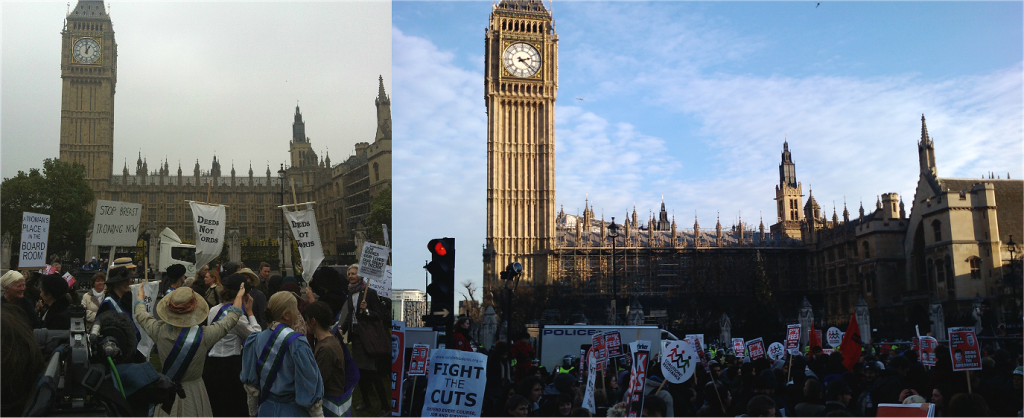
Suffragette photo by Victoria Gray, taken 24/10/2012; other photo by K Gupta taken 9/12/2010
POLICE SPIES AMONG THE MILITANTS.
LETTERS FROM A DETECTIVE.
The Suffragette this week says that in the attempt to repress the militant women’s agitation, the Government has enrolled an enormous number of plain-clothes political police, hundreds of whom prowl round the dwellings and meeting-places of suffragist leaders. It adds:-
At private meetings at times police spies are found, having gained admission by first becoming members of the Suffrage Society, under whose auspices such meetings are held, and gradually wormed their way into the confidence of staunch friends.
When it is difficult for some reason for a detective to join a suffrage society, the plan of employing spies is adopted. For a consideration these hirelings will do their best to find out the plans of the militants. The following specimens from correspondence duly authenticated will furnish some idea as to the methods of the so-called political department of Scotland-yard. The letters were sent through the post to a spy who had joined one of the men’s unions for woman suffrage, and were written by a well-known detective who has on more than one occasion participated in the arrest and trial of suffragists.
The letters quoted contain the following passages:-
Don’t fail to let me know if you are going to Town Hall, Battersea, on Thursday, and if S. P. will be there.
Sincerely trust that you suffered no ill effects from the wrestling bout in which I hear you took part, – old boy, try and go up and find out all you can re G- and D- (the names of two officials of a men’s union), or anything else going and let me know either by letter or tell me where and what time I can see you as I want to defray your out of pocket expenses. I am enclosing a postal order for you to have a drink, and hope you got the one I sent last week. In the meantime, – old boy, send anything you get to hear of concerning intentions of your union addressed to me at Scotland-yard, which will be opened and afterwards sent to me.
P.S.-In case anything is on during opening of Parliament, don’t forget to lot me have a line at office.
The same journal announces that Mrs. Pankhurst’s next public meeting will take place at Lowestoft on Wednesday, April 15.
The content of this article is startlingly contemporary: police gradually infiltrating activist organisations, gradually gaining trust and acceptance of their members and becoming trusted friends, but reporting everything to their handlers. This article, however, was published in 1914. I was reminded of it as I read this article about present day surveillance of activists. In it, Ellie Mae O’Hagan describes a conversation she had with a friend:
And then the conversation turned to something less unremarkable; something most people will never talk about with their friends. What if none of the memories we share, the secrets we’ve told each other, or the histories we’ve disclosed to one another were real? What if everything we knew about each other was based on a lie, so that one of us could extract information from the other that would eventually be used against them?
I am also based in Nottingham, and the uncomfortable fact remains that while I never met Mark Kennedy/Mark Stone, I have marched and occupied and planned and stood in the cold alongside those who did. In light of that, why should they trust me? Why should I trust them?
While there are lots of things activists can do to guard against surveillance – the Reporters Without Borders Handbook for Bloggers and Cyber-dissidents offers a good introduction to online and digital security – infiltration is very difficult to guard against. Is there much point in setting up elaborate email encryption if an infiltrator has access to the account password? Is there much point in carefully setting up meetings or using clean SIM cards and phones if someone has your details anyway?
Closely linked to police infiltrators is the role of the agent provocateur – someone from outside the activist organisation pretending to be part of the organisation and engaging in or encouraging acts that the activists themselves would be wary of. This can range from an agent provocateur slipping in amongst the black bloc to an embedded police infiltrator helping to plan and organise acts of direct action.
One of the posts I’ve read about police infiltration is this one discussing four main dangers resulting from infiltration. The problems of evidence gathered by the infiltrator, the emotional harm to activists and the potential for an infiltrator to disrupt, divide or derail the activist organisation seem pretty obvious but there’s a fourth danger – that of activist organisations becoming less trusting, more closed and more difficult for newcomers to get involved. As the article points out, it’s not newcomers who pose a threat; it’s our friends, lovers, co-workers, housemates – people embedded in our community – who are more likely to be infiltrators. As Mark Kennedy shows, it’s the people who put money into funding campaigns, dedicate a lot of their time and energy towards campaigns and are most enthusiastic about direct action who should worry us.
No Police Spies campaigns for an end to “political policing”; however police infiltration has been going on for a very long time. Suffrage campaigners were among the first to have their photos taken as part of police surveillance. These days, we call them Forward Intelligence Teams (FIT).
This newspaper article indicates a different form of police surveillance that again continues to be used today. It also raises interesting questions about the nature of police surveillance almost a hundred years ago – who was doing it? how extensive was it? were women among the hireling spies? and, perhaps inevitably, what was the relationship between the police infiltrators and direct action?

